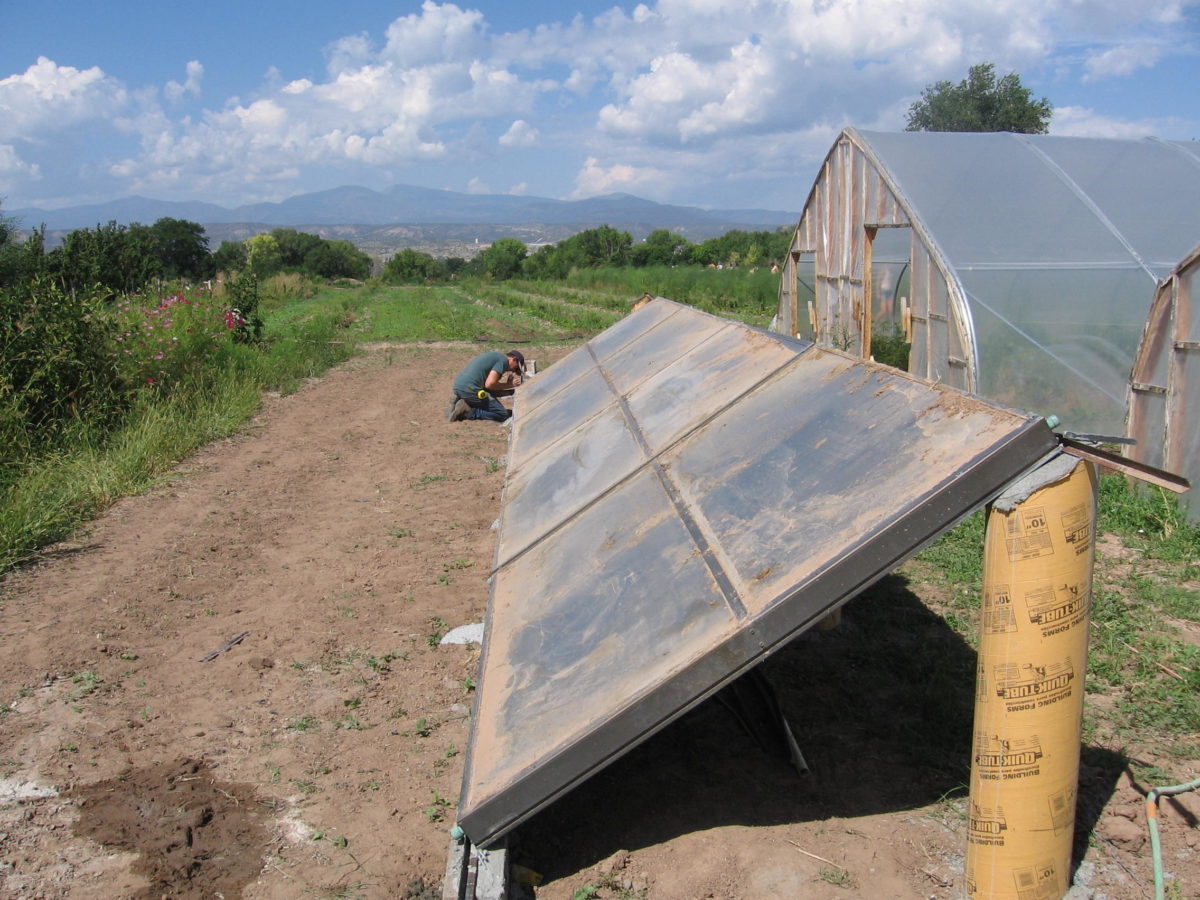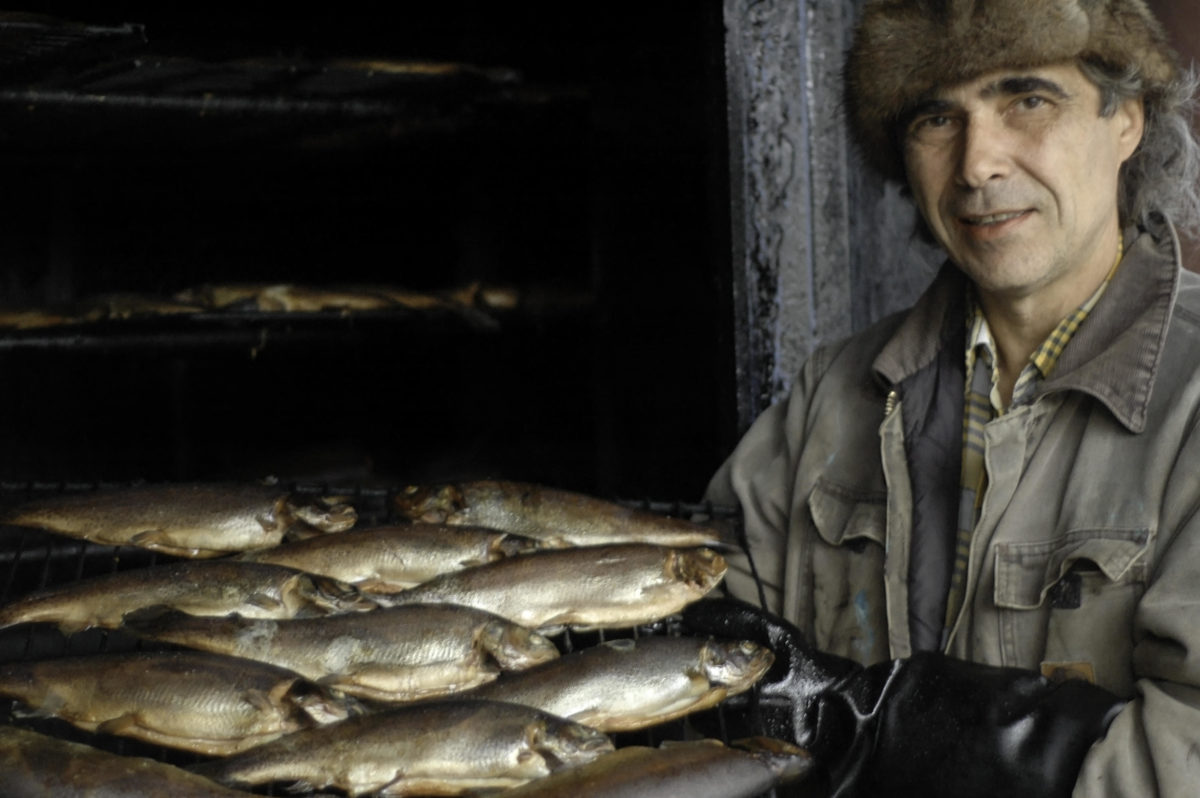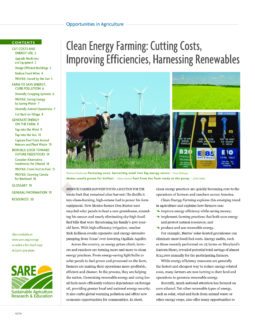Fifteen percent of agricultural production costs are energy related, according to the U.S. Department of Agriculture (USDA) – and as energy prices rise, these costs claim an ever-bigger portion of farm budgets. The quickest, cheapest and cleanest way to lower these costs, as well as cut non-renewable energy consumption, is by improving energy efficiency.

Upgrade Machinery and Equipment
Simple procedures, such as keeping tractor tires properly inflated and engines tuned, can go a long way toward saving fuel. Clogged air and fuel filters and injectors burn more fuel, as do motors or engines with rusty or corroded parts, worn bearings, loose belt drives and clogged condenser coils. Dirty fans can be up to 40 percent less efficient.
Replacing incandescent bulbs with fluorescents not only reduces energy use, but saves farmers money far beyond the original investment. An energy audit on a Maryland poultry farm, for example, found that switching the farm’s 40- and 60-watt incandescent light bulbs to five-watt cold cathode fluorescent bulbs required an initial outlay of $2,168, but would save the farmer $2,658 per year in energy costs. Given the bulbs’ 5–8 year life span, this farmer can expect total savings of $11,000-$18,000.
Modifying irrigation systems can also reduce energy and costs. According to the Natural Resources Conservation Service (NRCS), in certain areas of the United States, switching from high- to low-pressure sprinkler systems can save about $55 and 770 kWh per acre annually. In areas where ground and surface water is diminishing, efficient irrigation tools such as drip, trickle and lower-flow sprinkler systems save energy, water and money.
Dairy farms’ heavy reliance on electricity – mostly for collecting and cooling milk, heating water and lighting – provides many energy conservation opportunities. The Massachusetts-based Center for Ecological Technology (CET), which received a SARE grant to implement energy conservation measures, conducted an audit for dairy farmer Randy Jordan, showing him how much he could save with a variable speed drive. Variable speed drives use sensors to adjust pump capacity to demand, thus doubling efficiency and lowering expenses 50–80 percent. They cost from $1,800 for a five-horsepower (3.7 kW) unit to $7,400 for a 30-horsepower (22.4 kW) unit. But the significant energy savings for Jordan – as much as $4,750 per year – allow for a quick payback, from six months to four years.
Plate coolers – simple heat exchangers that take the heat from warm milk and transfer it to cold well- or pipe-water – are also excellent energy savers. According to Florida Cooperative Extension, plate coolers can save a 500-cow dairy farm as much as $2,000 per year in electricity costs or $750 in propane costs.
Design Efficient Buildings
Efficient buildings save money and improve comfort while reducing energy consumption. Properly sited windows light the inside of a building while operable windows and skylights can enhance ventilation and cooling, especially in regions with large nighttime temperature differentials.
Proper insulation also reduces heating and cooling expenses by protecting buildings against extreme temperatures. In an old dairy barn converted to a winter farrowing house, SARE grant recipient Gary Laydon of Plainfield, Iowa, insulated the small room where he keeps 35 pigs. Indoor winter temperatures rose by 20 degrees.
Greenhouses do their job most successfully using efficient designs and siting. In the Missouri Ozarks, SARE grant recipient Nicola MacPherson wanted to take advantage of the busy fall market for her shitake mushrooms without using more fossil fuel than necessary. So she built a 96-by-36-foot greenhouse “in-ground” to a depth of 3–4 feet in order to use the earth’s natural moderating properties against temperature extremes. She didn’t stop there. MacPherson heats the greenhouse by burning spent shitake logs in a clean-burning wood furnace that pumps fluid into tubes beneath a slab radiant-heated floor. A trench down the floor’s middle drains misting and irrigation water for the moisture-sensitive fungi and allows better side-to-side control of the heat. The wood furnace is so efficient that MacPherson has only needed the back-up propane water heater a handful of times.

Steven Schwen of Minnesota elevated efficient greenhouse design to an art form. He sited glazed windows to the south, and insulated the north side by building it against a small hill. He then harnessed the sun with a “thermal-banking” floor, which stores heat generated by the sun during the day to be released during the cold nights. He also installed a solar-powered variable speed fan, which helps blow hot air under the soil, heating it to germination-friendly temperatures. Schwen has been able to maintain steady temperatures to grow frost-tolerant crops, such as salad mix, braising greens and herbs. (See SARE’s video series on Steven Schwen).
“In February, even if it’s below zero, the greenhouse is in the mid-20s and the ground inside doesn’t freeze,” said Schwen. “Later in the month, when it’s ten degrees outside, we can take advantage of the sunny days and maintain a temperature differential of 40 degrees between the inside and outside.”
Although Schwen only grows frost-tolerant crops in the winter, he occasionally uses a wood stove for back-up heat. He also plans to install a wood-fired boiler to pipe hot water through radiant floor heating so he can grow less hardy winter crops. Although the greenhouse is entirely off the grid, Schwen plans to eventually install more solar panels and a wind turbine to avoid purchasing fuel or electricity for the rest of the farm.
Like Schwen, Leonardo Busciglio of Bearsville, N.Y., wanted the energy captured by the sun to do double duty. He took a tanker trailer and sliced it longitudinally in half to form a huge 4,000-gallon trough (Note: Many types of tanker trailers, such as fuel and chemical, are not suitable for reuse). The tank, which must be big enough to keep the water from freezing, absorbs heat during the day and releases it back into the greenhouse at night. He also uses the tank to raise trout and tilapia. Busciglio discovered yet another benefit from the water tank: The ever-present humidity means his salad greens and watercress no longer need misting.
Busciglio, who used a SARE grant to add both solar and wind to his operation, operates a wood furnace about an hour per day during the coldest days to keep the water temperature optimal for the fish and, when necessary, to maintain temperatures in the greenhouse. He runs the fish waste through a bio-filter, which kills the algae, and then recycles the filtered water as plant fertilizer. “In the winter before I installed the water tank, I couldn’t grow enough to afford the propane to heat the greenhouse, but now it’s profitable,” said Busciglio.
Reduce “Food Miles”
According to a study done by Iowa’s Leopold Center for Sustainable Agriculture, food travels, on average, 1,500 miles before reaching the plates of Midwesterners. In the same study, researchers found that food trucked into Iowa used an average of four times more fuel and five times more CO2 than a locally supplied and marketed system. Community supported agriculture (CSA), direct marketing, farmers markets and on-farm sales are just some of the many time-tested methods that can cut energy-intensive “food miles” drastically, while also providing marketing advantages for growers and benefits to the community.
- Community supported agriculture (CSA): In a CSA, members of a community invest in a local farm operation by paying up front for a share of the harvest. CSAs have been growing steadily since the 1980s, providing members with an increasing variety of products.
- Direct marketing to local restaurants and institutions: More and more farmers are tapping into burgeoning consumer interest in locally grown food by marketing directly to restaurants. In Arkansas, a SARE grant helped establish a network of farmers and chefs, resulting in a weekly listing of available products for chefs and restaurants. Selling to local institutions is another increasingly popular option. St. Andrews High School in Delaware tries to purchase all of the school’s pork products, honey and many of its fruits and vegetables from within a 100-mile radius.
- Farmers markets: Since 1994, the number of U.S. farmers markets has more than quadrupled to about 7,800, reflecting an enormous demand for farm-fresh produce. Most farmers markets offer a reliable, flexible outlet where vendors can sell a wide range of fresh produce, plants, honey, value-added products like jams or breads, and even (depending on local health regulations) meats, eggs and cheeses.
- On-farm sales: “U-pick” farms, or on-farm stalls and shops, bring local customers to the farm. This has an added advantage: Farmers can raise consumers’ awareness of how the food is produced and promote its quality.
